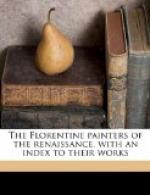it is scarcely necessary to point out with what processional
gravity, with what hieratic dignity, with what sacramental
intentness he endows it; the eloquence of the greatest
critics has here found a darling subject. But
let us look a moment at certain of his symbols in
the Arena at Padua, at the “Inconstancy,”
the “Injustice,” the “Avarice,”
for instance. “What are the significant
traits,” he seems to have asked himself, “in
the appearance and action of a person under the exclusive
domination of one of these vices? Let me paint
the person with these traits, and I shall have a figure
that perforce must call up the vice in question.”
So he paints “Inconstancy” as a woman
with a blank face, her arms held out aimlessly, her
torso falling backwards, her feet on the side of a
wheel. It makes one giddy to look at her.
“Injustice,” is a powerfully built man
in the vigour of his years dressed in the costume
of a judge, with his left hand clenching the hilt
of his sword, and his clawed right hand grasping a
double hooked lance. His cruel eye is sternly
on the watch, and his attitude is one of alert readiness
to spring in all his giant force upon his prey.
He sits enthroned on a rock, overtowering the tall
waving trees, and below him his underlings are stripping
and murdering a wayfarer. “Avarice”
is a horned hag with ears like trumpets. A snake
issuing from her mouth curls back and bites her forehead.
Her left hand clutches her money-bag, as she moves
forward stealthily, her right hand ready to shut down
on whatever it can grasp. No need to label them:
as long as these vices exist, for so long has Giotto
extracted and presented their visible significance.
[Page heading: GIOTTO]
Still another exemplification of his sense for the
significant is furnished by his treatment of action
and movement. The grouping, the gestures never
fail to be just such as will most rapidly convey the
meaning. So with the significant line, the significant
light and shade, the significant look up or down,
and the significant gesture, with means technically
of the simplest, and, be it remembered, with no knowledge
of anatomy, Giotto conveys a complete sense of motion
such as we get in his Paduan frescoes of the “Resurrection
of the Blessed,” of the “Ascension of
our Lord,” of the God the Father in the “Baptism,”
or the angel in “Zacharias’ Dream.”
This, then, is Giotto’s claim to everlasting
appreciation as an artist: that his thorough-going
sense for the significant in the visible world enabled
him so to represent things that we realise his representations
more quickly and more completely than we should realise
the things themselves, thus giving us that confirmation
of our sense of capacity which is so great a source
of pleasure.
III.
[Page heading: FOLLOWERS OF GIOTTO]




